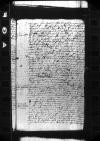Wir habn(n) dissen tag E(wer) H(erlichkei)t ⌊⌋ mit der citacion(n), / di written over E(wer) H(erlichkei)t⌈E(wer) H(erlichkei)t di di written over E(wer) H(erlichkei)t⌉e wir besigelt, / erhaltn(n), / danckende E(wer) H(erlichkei)t, das die uns der gestalt besucht / und sich erbotn(n), / so wir was bei ⌊f(urstlicher) d(uchlauch)t⌋ und zu Heilsberg on the margin⌈und zu ⌊Heilsberg⌋und zu Heilsberg on the margin⌉ zu thun etc. Woruff wir bitt(en), / so E(wer) H(erlichkei)t gesunt do hin gelanget, / uns / nebn(n) unsern(n) freuntlichn(n) dinst(en) ⌊f(urstlicher) d(urchlauch)t⌋ zu befhelen(n), / ouch weiter sich nicht besveren, von f(urstlicher) d(urchlauch)t antwurt zu furdren um(m)b das gut ⌊Rapt(en)⌋, dar uff unser arm(m) man, der moler meist(e)r ⌊Simon⌋, uber III C m(a)rc(en) geligen(n), / des er gutt(en) schein und beweis hoth, / wie dan das aus unser stad ⌊Lobau⌋ buch etlich mal an f(urstliche) d(urchlauch)t geczeuget / und nichts anders dar noch gefolget, / dan das im uff E(wer) H(erlichkei)t vorbitt zum ⌊Preusschenmarckte⌋ geschen, / etlich stuk seins vihes do von ist wider worden(n), / des ⌊guts⌋ aber mus mues, do von er im krige und darnoch alle pflicht gethon / und mit rechte nye dar von gewisen, / entporen mues. / Hirum(m)b ist unser fruntlich bitt, disser sachn(n) ⌊f(urstliche) d(urchlauch)t⌋ wolt erinnern(n), / das unserm(m) armen ⌊man(n)e⌋ folg(en) mocht, / dar zu er guth fueg und recht hoth, / oder aber gruntlich zu erfaren(n), worum(m)b im solch sein gut vorgehalten(n) und entczogen(n) wirt, derweg(en) wir bisher von f(urstlicher) d(urchlauch)t, / die wir etlich mol durch botschafft und schriffte besucht, / kein entlich antwurt habn(n) mog(en) / wissen(n) etc. Wie uns ouch E(wer) H(erlichkei)t anczeigt von ⌊Konigsberg⌋ uff ⌊Heilsberg⌋ sich zu begebn(n), / wolle wir E(wer) H(erlichkei)t nicht berg(en), das wir dissen tag superinscribed⌈tagtag superinscribed⌉ antwurt von dannen(n) wart(en). / Do hin wir uns ouch zu komen(n), / so weit es uns nicht wurd abgeslag(en), / vorgenomen(n) / und do / mit dem h(e)rn ⌊custos⌋ und seinem(m) ⌊collega⌋ das so fueglich bey uns hir nicht wol geschen kan on the margin⌈das so fueglich bey uns hir nicht wol geschen kandas so fueglich bey uns hir nicht wol geschen kan on the margin⌉, alles zu beslissen(n). So(?)n(n) Wurd aber uns dis unser vornhemen(n) fhelen, / sey wir des h(e)rn ⌊custodis⌋ und seins college dissen zukumfftig(en) suntags hie warten(n). / Was sich in dissen hendlen wirt zutrag(en) und unser both von hove, / der teglich komen(n) sol, / mit wirt breng(en) on the margin⌈und unser both von hove, / der teglich komen(n) sol, / mit wirt breng(en)und unser both von hove, / der teglich komen(n) sol, / mit wirt breng(en) on the margin⌉, wolle wir mit den erst(en) E(wer) H(erlichkei)t nicht vorhalt(en). / Es wer uns fast lieb, das wir zu ⌊Heilsberg⌋ zu samme mocht(en) komen(n). / So nicht, / bit wir E(wer) H(erlichkei)t, im w written over v⌈vww written over v⌉iderzcoge uns nicht wolde vorbey zcyhen(n) etc. Vor die zceitung(en), / die noch nicht zu fried leuten, / dancke wir Euch. / Bey uns ist nichts newes, / dan das unser g(nedigste) ⌊frau konige⌋, / wie uns ⌊Fabian Woynowski⌋ schreibt, / krank zu bette das mol geleg(en) ist. / Got der almechtige, / dem wir E(wer) H(erlichkei)t befhelen, / gebe ir ⌊m(ajeste)t⌋ und uns, was zu sele und leib gut ist. /

 AAWO, AB, D. 7, f. 33r
AAWO, AB, D. 7, f. 33r